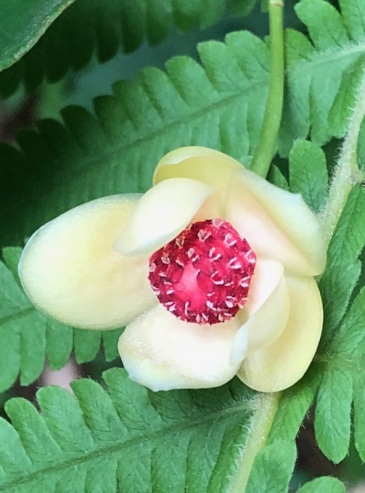Kadsura Vine or Kadsura japonica
On September 30, 2016, I noticed a vine growing along the roadside near the end of Holly Hedge Road. The vine was most notable for its large, dark green leaves and its clambering nature. It sprawled along the ground and climbed and twined on nearby woody plants. While there are many native vines in our area, this one did not match any of the common vines I was familiar with. I collected a small vegetative sample and returned to the Archives. I proceeded attempting to identify it using the Woody Plants of Acadiana Flora. The vine only matched Schisandra glabra, the Bay-Star Vine.
Schisandra is an extremely rare vine found in the eastern United States. Once considered a member of the Magnolia family, it is now classified in its own family, the Schisandraceae. I emailed photos to Charles Allen, who is very familiar with Schisandra. He agreed the vine resembled Schisandra glabra.
As I continued to explore this area I found more of the vine growing in great abundance, climbing a dead tree in full sun. This habitat is most atypical for our native Schisandra, which never seems to occur in great abundance and normally prefers a dense forest canopy. In the absence of flowers and fruits it was impossible for me to proceed any further with the identification. However, I remained suspicious of this vine’s true identity.
In early March 2017 Richard Olsen, director of the National Arboretum in Washington, D.C., visited Avery Island. We spent the day together in Jungle Gardens. I showed him all of the odd plants I had discovered. When I brought him to the “Schisandra” vine and asked his opinion, he immediately recognized it and said, “That’s Kadsura japonica.”
Kadsura, a native of Japan, is very closely related to Schisandra and is the only other genus in the family Schisandraceae. The discovery that this vine was not Schisandra, but in the same family, was more exciting to me than if it had been our native Bay-Star Vine. It meant that E. A. McIlhenny had planted this vine in Jungle Gardens no less than 70 years earlier, and it has survived and thrived all on its own with no human attention.
The Kadsura vines are scattered primarily along the south side at the end of Holly Hedge Road. There is one large mass of vines growing in full sun and numerous small separate plants growing nearby in dense shade on both sides of the road, some distance apart. The presence of these individual plants in the immediate vicinity of the massive Kadsura growth suggests its spread could be the result of seed dispersal. Alternatively, given the length of time the population of Kadsura has been at this location, its spread could also be the result of long-term vegetative growth.
On August 8, 2017, while exploring the location with Herbert Levitt, he discovered a vine with flowers. A small pendant vine on a holly tree had numerous small, yellow, axillary flowers. We searched for and found several additional vines in the immediate vicinity with flowers. All flowers observed were identical.
Kadsura plants are always unisexual, producing either male or female flowers but never both on the same vine. I feared that the entire population might all be descended from a single introduced plant and thus be unable to produce fruits and seeds.
At that time I thought the flowers we found were staminate, essentially “male,” but now, one year later, I realize they were all pistillate “female” flowers. None were staminate.
On June 19, 2018, I was again visiting the Kadsura locality with Shane Bernard and found several different vines with flowers. These flowers were noticeably unlike those we had found the previous year. This time I could tell these were staminate flowers. Now I knew both sexes were present in the population.
Therefore, there is hope that both male and female plants could be found growing in close proximity, increasing the chances that fruit and seeds could be produced.
The very next day, June 20, 2018, Leigh Simmons and I returned to photograph the flowers. We ventured across the road where I had previously found a small group of vines growing. Much to our delight we observed many flowers at this location, and it was immediately noticeable that the flowers were of two types. We collected several and brought them back to ARCHIVES for closer examination. Using a microscope, I was able to determine that we had found both male and female flowers at this one location.
I revisited the Kadsura location during the second week of July 2018 and found an abundance of mature flowers on many vines on both sides of the roadway. This time I could clearly see flowers of both sexes, present in areas where I had previously only observed a single sex.
Now we patiently wait to see if any fruits with seeds will be produced.



